Hall of Fame honour for SA’s wheelchair basketball champion
Paralympic gold medallist and basketball legend David Gould OAM has been selected to join the SA Sport Hall of Fame, with the proud South Australian recognised for one of the most decorated careers in wheelchair sport.

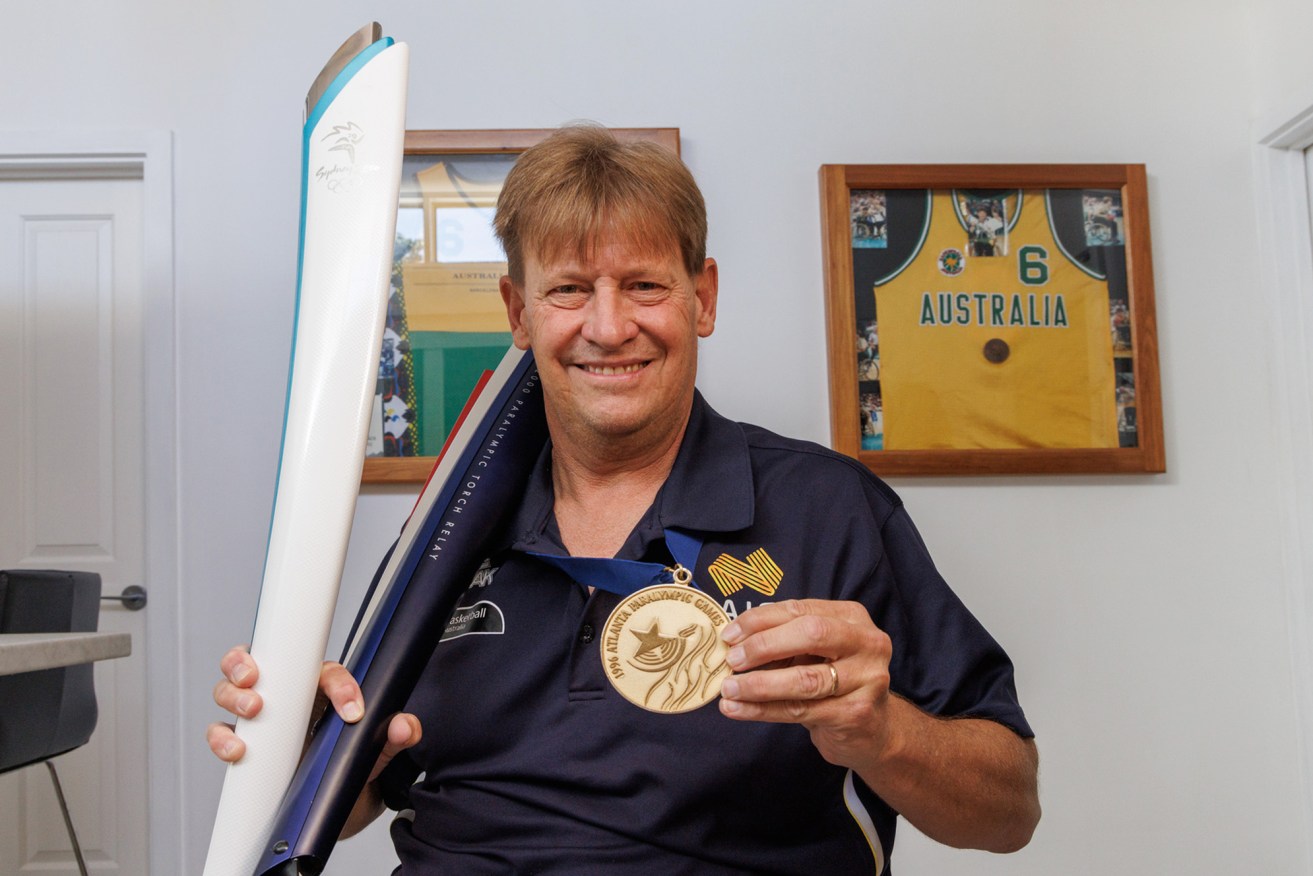
David Gould, proudly displaying his 1996 Paralympic gold medal and Sydney Olympic and Paralympic torches, is the fourth inductee into the Hall of Fame this year. Photo: Tony Lewis/InDaily.
Gould represented his country at a near-record five Paralympics and led the Australian Rollers to an historic triumph at the 1996 Games in Atlanta – taking home the first-ever gold medal won by a senior Australian basketball team at Olympic or Paralympic level.
A crafty scorer with a lethal interior shot, Gould could get to the basket quicker than his opponents and play tall despite his smaller stature.
His elite scoring talents garnered global recognition and a spot on the World All-Star Five in 1994 and the All-World Team which faced the United States in 1996.
Closer to home, he was dominant in national competition – winning five championships for South Australia and leading the league in scoring every year from 1984 to 1991. He was also named Most Valuable Player in 1985.
In the later formed National Wheelchair Basketball League, Gould won three championships with the Adelaide Thunder from 1993 to 1995, including an undefeated season in 1994 and an MVP award a year later.
He retired in 2002 after playing in his fifth world championship but later came back as a senior coach with the Australian women’s wheelchair basketball team. In his more than 35 years as a player and coach, he represented Australia on more than 550 occasions.
Despite a near-fatal shooting accident in 1977 ending his dreams of a career in able-bodied basketball, Gould will soon be a member of both the SA Sport Hall of Fame and Basketball SA Hall of Fame.
Reflecting on his career now, Gould tells InDaily he “couldn’t have asked for anything else” and attributes much of his success to family and friends.
“I’ve had a lot of support from family, from my mum who passed away, my brother, my wife, my kids have always supported me throughout my career,” he said.
“I really wouldn’t have achieved what I’ve achieved if it wasn’t for family and friends.”
The 56-year-old will be the seventh basketballer – and first wheelchair basketballer – inducted into the Hall of Fame, joining Australian cricketer Jason ‘Dizzy’ Gillespie, Olympic diver Valerie Beddoe AM and sailing administrator David Tillett AM in the class of 2021.
“If you look at some of the people that have been inducted before, it’s an amazing list and to be included in that list is just a privilege and an honour,” Gould said.
“I grew up watching [2010 basketball inductee] Phil Smyth play and he was just my idol, and [2020 inductee] Michael AhMatt, I watched him play as well towards the end of his career.
“To have two players like that who are inducted and I’m going to be inducted as the third male is just unbelievable.
“It’s just something that I never expected would ever happen to me.”
Two more SA Sport Hall of Fame inductees will be profiled by InDaily over the coming fortnight ahead of the black-tie event at Adelaide Oval on April 8.
Trauma, tears, triumph and sacrifice
It was August 25, 1996, when the final buzzer sounded at the Omni Coliseum in Atlanta.
Triumphantly sitting on the shoulders of a teammate, Gould is helping a euphoric Troy Sachs – the Australian who has just scored a record 42 points in a Paralympic final – to “cut down the net” at centre court in a time-honoured basketball tradition.
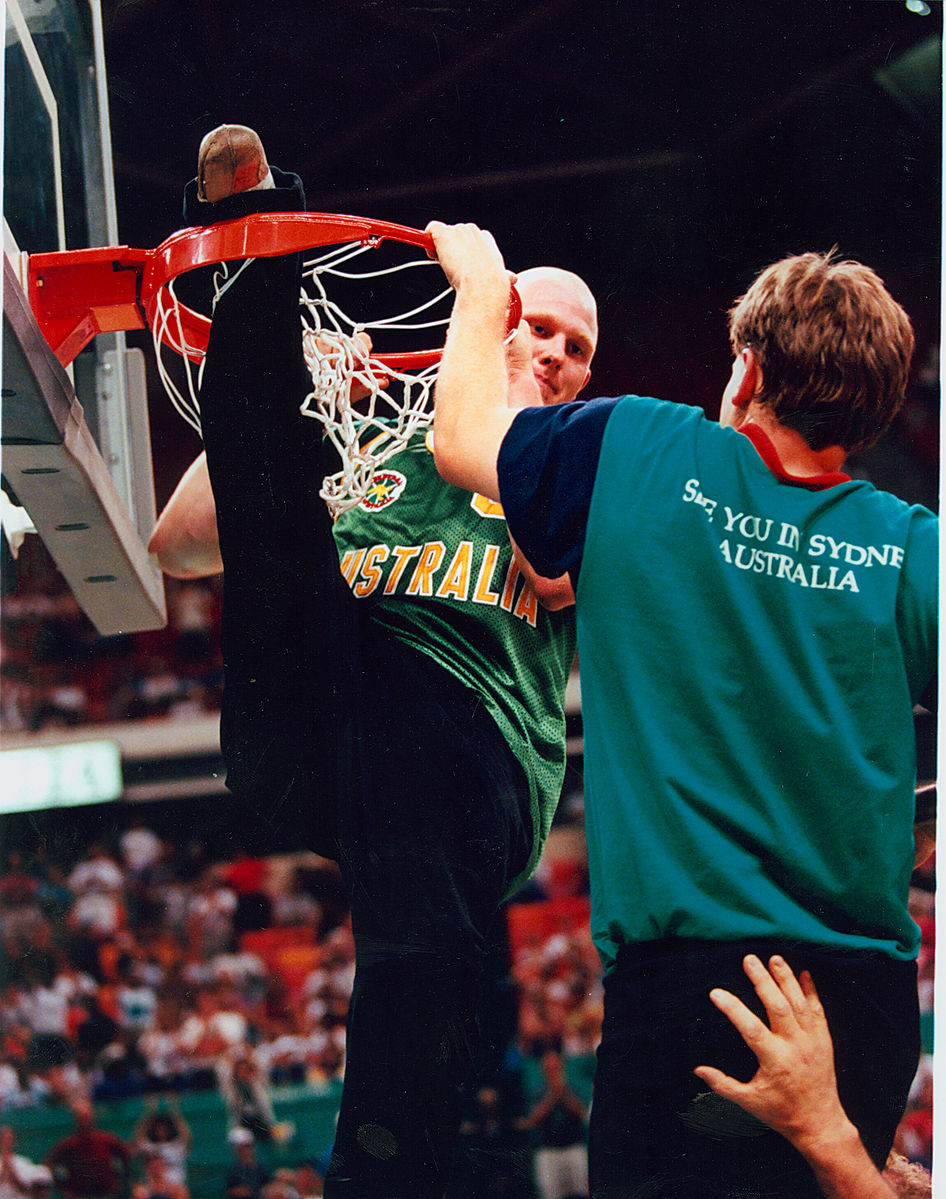
David Gould (nearest) helps star teammate Troy Sachs “cut down the net” to celebrate their Olympic Gold Medal. Photo: John Sherwell/Australian Paralympic Committee.
Gould has co-captained Australia to its first-ever senior basketball gold medal in a gutsy come from behind win over the old enemy Great Britain. He later embraces his wife Karen at the halfway line.
“Tears were running down her eyes, tears running down my eyes,” Gould recalls.
“Neither of us believed what we just achieved.”
Twenty years earlier, Gould did not know the sport of wheelchair basketball existed.
In 1976, he was a developing young basketballer representing South Australia and using his legs to keep up with the likes of Andrew Gaze in state competition.
“Back then no one knew who this kid was, it was Andrew Gaze and he just gave me a bath – it was unbelievable,” Gould said, noting that his coaches kept faith in him to guard the Victorian star for the rest of their five-game series.
“I’ve often said to people that I used to play defence on him and they look at me strangely.
“It’s just an honour to one: make that team, and two: be offered or asked to try to look after him.”
On July 15, 1977, Gould’s life changed forever.
Playing with slug guns at a mate’s house, he was nearly killed when his friend picked up the wrong weapon under a bed and accidentally shot Gould in the back with a loaded .22.
At 12 years old, Gould was informed that he would be in a wheelchair for the rest of his life.
The incident left him with months of gruelling rehab and without the sports that were such an integral part of his childhood.
Asked how he was able to recover mentally and physically from the life-changing incident, Gould said: “The short answer is just family and friends – I had a very supportive family.”
“Probably one of the advantages I had is that I was so young,” he adds.
“If it happened a bit later in life it would have been a lot harder to try and turn that around.
“They say the younger you are the easier it is to get over traumatic accidents.”
After navigating a long and arduous recovery, Gould would try to return to basketball through school coaching.
“I found it really really frustrating,” he said of the experience.
“Because you’d give instructions and kids weren’t following it and you just wanted to go out there and show them but I wasn’t able to.”
It would take another few years until Gould was introduced to his life’s passion as a 16-year-old.
I had no exposure to the sport at all.
Gould’s brother, who was playing social wheelchair basketball at the time, asked David to come down to watch a game.
“When someone mentioned wheelchair basketball to me, I just thought it was going to be an old man in a wheelchair because they couldn’t walk or run anymore,” Gould said.
“I didn’t understand what wheelchair basketball is like, what you can achieve and how far you can go.
“I had no exposure to the sport at all.”
By fortune or by set up, one of the social teams Gould thought he would be watching that day was a player short.
Asked if he wanted to play, Gould took the opportunity “with both hands”.
“The state captain and coach were watching at the time and asked me if I’d like to come out to training,” Gould said.
“And it went on from there and I started to go out to state training and made the state team.”
Wheelchair basketball squads draw on a range of athletes with different sporting backgrounds who have been living with different disabilities for varying amounts of time.
While Gould’s background in able-bodied basketball put him in good stead to pick up the wheelchair game quickly, the youngster still had a lot to learn about the notoriously difficult “chair skills”.
“If you haven’t got good chair skills, it’s no good having good ball skills,” Gould said, highlighting that he had to spend one hour each weekday on chair drills for about six months to get up to speed.
The training involved “a lot of work pushing between cones, getting to a cone, stopping, turning, going backwards”.
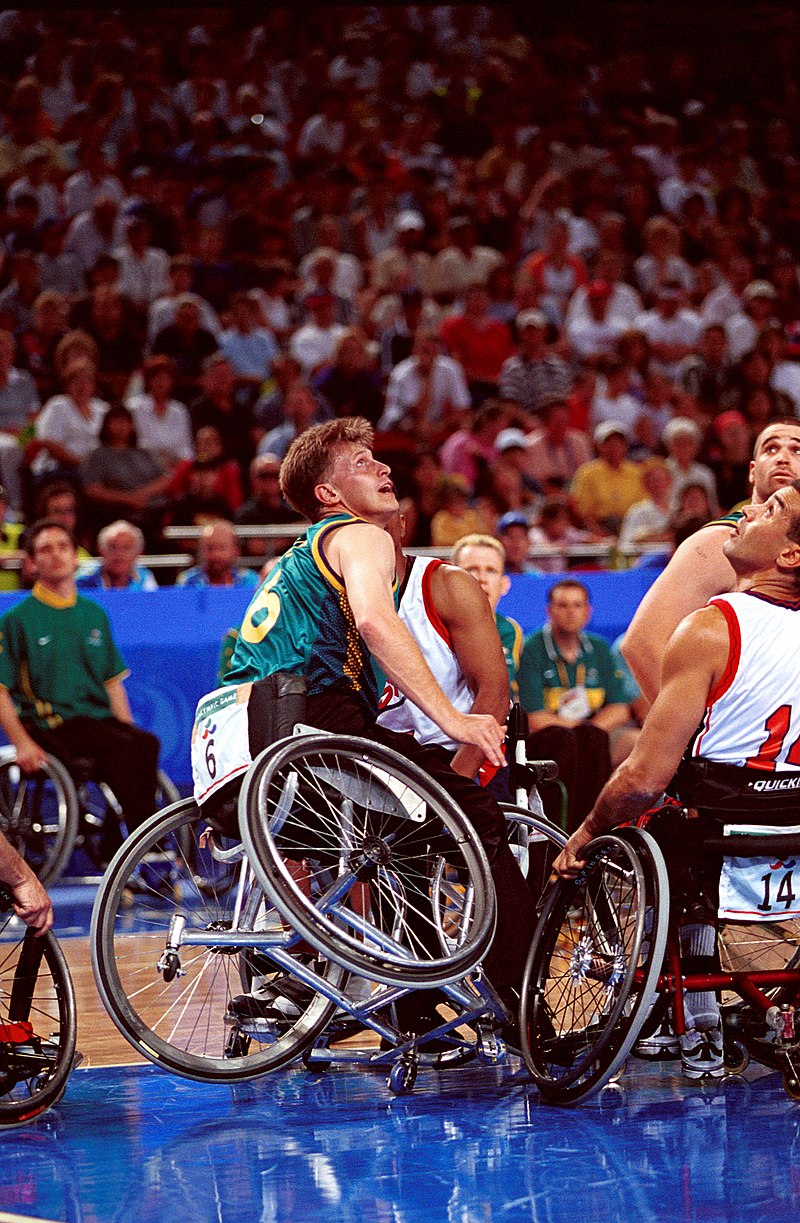
Gould deploying his “chair skills” at the Sydney Olympics in 2000. Photo: Bill Bachman
“Once you get all of that then you introduce a basketball and then you’ve got to do it with a basketball again,” he said.
“So I definitely had an advantage of understanding the game, definitely had an advantage with my ball skills, but had to work hard on the chair skills.”
Teething problems aside, Gould’s rise to the top of his newfound sport was swift.
One of his favourite early career memories is scoring the game-winning shot against Victoria in 1982 to win his first national championship as a 17-year-old. “Any time you beat Victoria it’s fantastic at any sport,” Gould says with a big grin.
The energetic South Australian began to catch the eye of national selectors and eventually earned a place in the 1983 Australian Paralympics training squad with the 1984 Games bearing down.
Desperate for a Paralympic ticket, Gould had a career-best third season in the national league – top-scoring, winning SA’s Best and Fairest and making the All-Star Five.
“I had several people telling me that you’re going to play for Australia you’ve got the skills,” he said.
It was just an achievement which I wouldn’t have thought would happen at 12 years of age when the doctors came in and told me I’d be in a wheelchair for the rest of my life.
“But I always had that I guess it’s self-doubt of ‘wow this is so hard, it’s going to be hard to play for you country.”
When selection day came, Gould said he was “still just so nervous sitting there with sweaty palms and sweaty hands”.
“[I was] thinking: ‘I’m not going to make this team; I’m not going to make this team, and I’ve put everything in and I’ve worked so hard and I’ve trained so hard’.”
Gould ended up being the first name called out.
“Everything from there was just sort of done I guess – the relief off my shoulders that I made it was just fantastic,” he said.
“It was just an achievement which I wouldn’t have thought would happen at 12 years of age when the doctors came in and told me I’d be in a wheelchair for the rest of my life.”
‘A real eye-opener’: Performing on the world stage
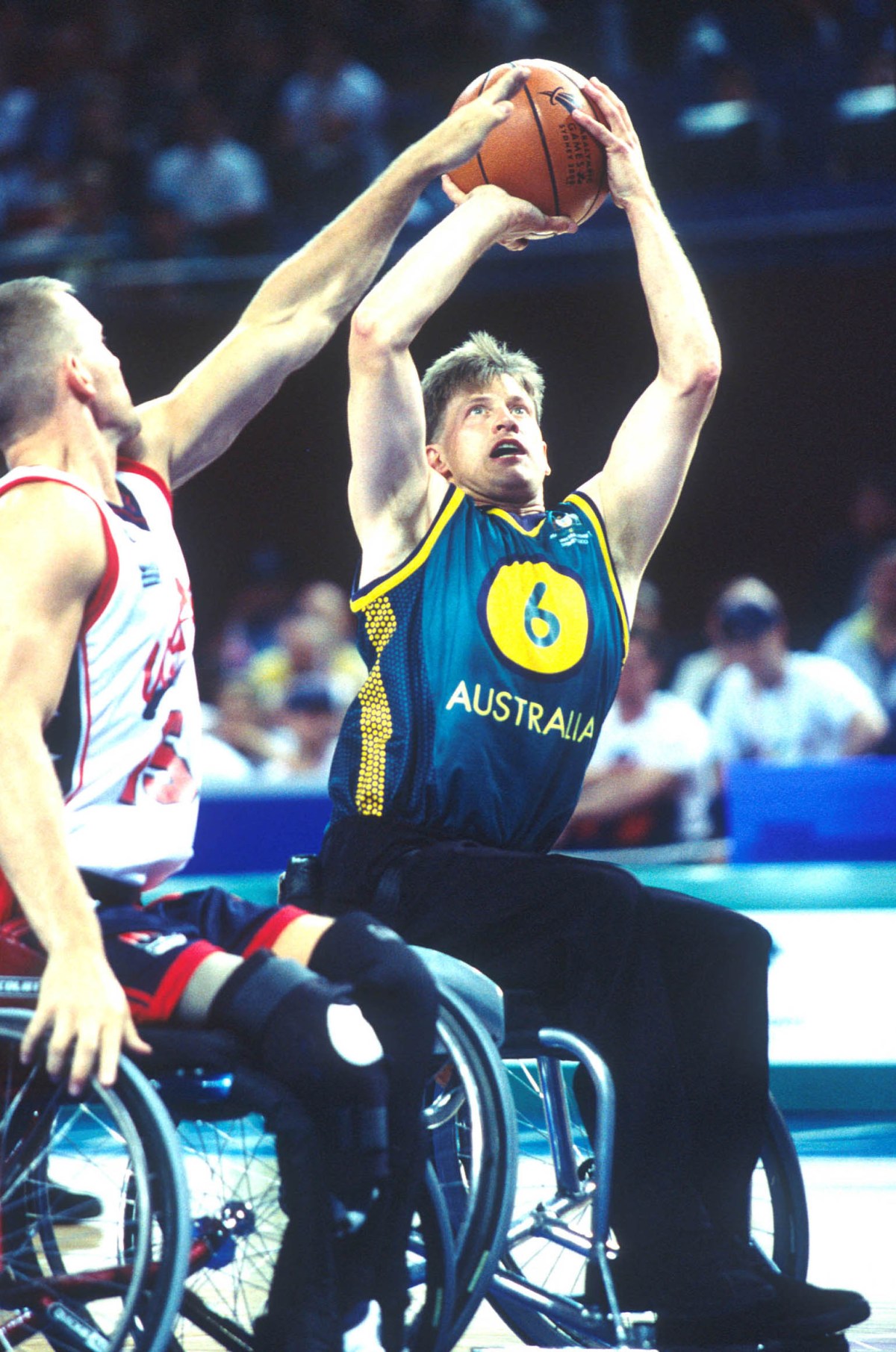
Gould’s first hit out against international competition was a career-defining reality check. Photo: Australian Paralympic Committee
Gould speaks about all five of his Paralympic experiences with reverence, even those in which his side was comprehensively defeated.
Heading to England for the 1984 Games as a wide-eyed and confident 19-year-old, Gould soon got his first sense of how far away Australia was from achieving Paralympic glory.
“We thought Australia was going to win the gold medal and we thought we were going to be fantastic,” he said about the side which finished rock bottom in a 12-team competition.
“It was just a real eye-opener.
“I think any athlete has to have a competition like that because you just learn so much.
“After those Olympics, I realised I’ve got to do a lot of work; the team, Australia, has to do a lot of work.
“And that’s really where it all started.”
Balancing a job as a sheet metal apprentice, Gould would begin a rigorous morning and evening training routine with his South Australian teammates, four of whom were in the national squad.
The thing you’ve got to realise with wheelchair basketball in Australia is that we never had a big budget
Amidst the wheelchair basketball grind came cracked ribs, broken thumbs, shoulder problems and a broken nose, but Gould’s resolve and the commitment of his teammates remained undeterred.
“You just drag people along with you … we always push each other,” he said.
“You’d wake up one morning at 5:30am, you’d have a weight session at 6, you didn’t want to go, you didn’t want to get out of bed.
“But when you got there … the other members of the team were pushing you, and vice versa.
“The thing you’ve got to realise with wheelchair basketball in Australia is that we never had a big budget, so all of the training sessions had to happen in your hometown.
“Coaches might send out a program that you have to follow, but you had to make sure you went out and did it.”
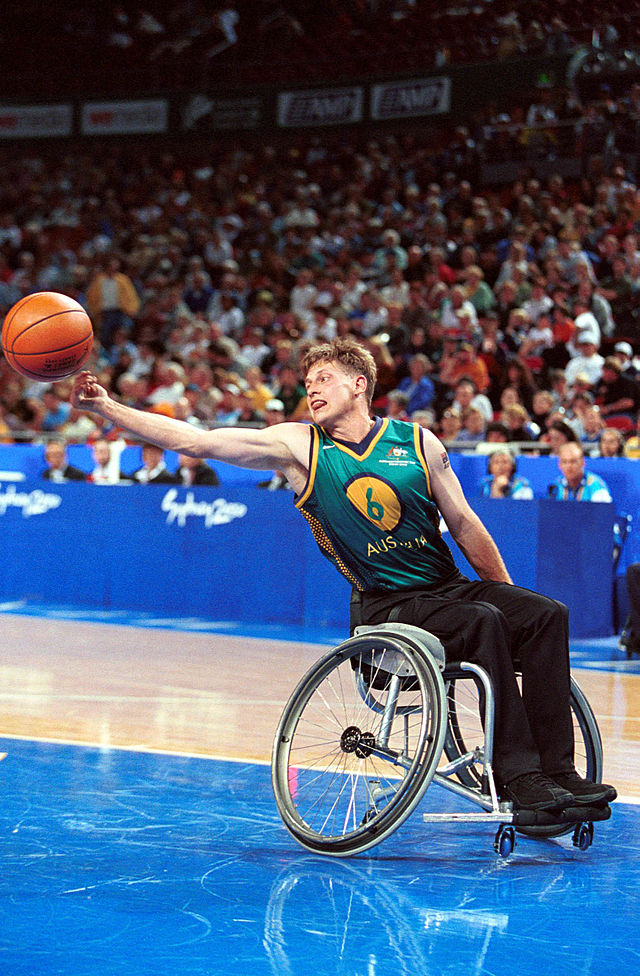
Gould sustained a number of injuries during him time as a player. Photo: Australian Paralympic Committee
Australia’s results improved steadily if not quickly. The team would place 10th at both the 1986 World Championships in Melbourne and the 1988 Paralympics in Seoul, with Gould top-scoring in the latter and describing the team’s performance as a “huge improvement”.
Four years later at the 1992 Barcelona Games, the Aussies considered themselves an outside medal chance if things went their way.
The Rollers would finish eighth but were closing the gap on teams that had blown them out eight years earlier.
Gould emphasises that the turning point for his squad came at the 1994 world championships in Canada when the Australians, playing against Great Britain in the quarter-final, blew a significant lead and squandered their best opportunity to reach their first-ever final four.
Seeing everyone and how upset they were, I just knew we were going to do something special going forward.
“We got into the change room [after the game] and several of us were bawling our eyes out because we were so close yet so far away,” Gould said.
“It was at that point I knew this group of guys was going to be successful going forward.
“It’s vivid in my memory that we were so close, we’ve got to learn from this experience and move on.
“Seeing everyone and how upset they were, I just knew we were going to do something special going forward.”
Yet a tumultuous build-up would greet the Australians on their road to Atlanta 1996.
Persistent infighting and a 12-game losing streak ahead of the Games meant the Rollers – now under Gould’s leadership as co-captain – looked destined for another international disappointment.
After a series of honest meetings where “we just laid everything on the table”, Gould’s team made a pact to transform themselves from the world’s worst foul shooting team to the best.
As part of the agreement, each player would have to take 150 foul shots a day.
“If you didn’t do it, you were letting yourself down, but more importantly you were letting your teammate down,” Gould said.
“In the end, we became the best foul shooting team in the world.
“And some of the games in ’96 relied on foul shots to get us over the line.”
After dropping their first group game in 1996 to Spain, the Rollers won four straight to book a quarter-final clash with the highly-fancied Netherlands.
“To me the biggest hurdle was the quarter-final,” Gould said
“We’d never beaten the Netherlands before in our lives and we had to play them in a quarter-final.
“It was a very low scoring game, so it was very defensive and we just had to dig deep.”
With scores level and Australia’s final possession in his hands, Gould attracted a triple-team at the elbow and was able to set up his teammate under the hoop for an easy score. A desperate heave from the Netherlands was no good and suddenly a jubilant Australian team was playing in its first-ever semi-final.
“Then we got told we were playing the USA,” Gould said.
“So [the mood] went from being up here to down here thinking ‘ugh, the USA are the best team in the world and once again we’ve never beaten them at full strength’.”
Faced with playing the reigning Olympic and world champions on their own court, the Australians played into their underdog status.
“I remember going past the American change room and the USA coach saying to the team ‘alright guys we’re only playing Australia here, they shouldn’t be here, let’s go out and give them a basketball lesson’,” Gould recalls.
“I heard that and I just saw red and I was fuming.”
“I mentioned it to a couple of the guys, we warmed up and went out on the court – and they started to give us a basketball lesson.
“We were 15 [points] down very very quickly.”
With the plot going to script, the Rollers would have to engineer a reset and pull back a big margin from wheelchair basketball’s “dream team”.
“Coach [Mark Walker] had some smarts and he called a timeout, changed a few things up and we just settled down and said ‘take a deep breath there’s a long time to go’,” Gould said.
“And we started to peg them back … and once we hit the front they just couldn’t stop us.”
Holding a tenuous three-point lead with just over a minute left in the game, Australia’s foul shooting which they had so rigorously drilled in the months prior would get them over the line.
Veteran Sandy Blythe knocked down three foul shots to extend the Rollers’ lead beyond doubt and secure one of Australia’s greatest-ever wins in wheelchair basketball history.
“To beat USA in America is something I’ll never ever forget,” Gould said.
“When we went into the change room, I remember saying: ‘alright guys, well done, great achievement, this is something we’ve never done before … enjoy it, but now we’ve got something to lose’.
“‘We are seven-eighths the way up Mount Everest, now let’s get to the top.”
Gould recalls being greeted back at the Olympic village as heroes but enduring what felt like the longest 36 hour wait for a basketball game in his career.
Only Great Britain stood between Gould winning gold at his fourth Paralympics. But the Australians would again make it difficult for themselves by giving up another 15-point margin to start the Olympic final.
Yet the Rollers – playing a tenacious brand of defence complimented by Troy Sachs’ record-breaking 42-point performance – stormed over the top of the Brits, winning comfortably 78-63 and taking home a landmark medal in Australian basketball history.
For their efforts, Gould and his 11 teammates would all be awarded Medals of the Order of Australia upon their return home.
Carrying the torch
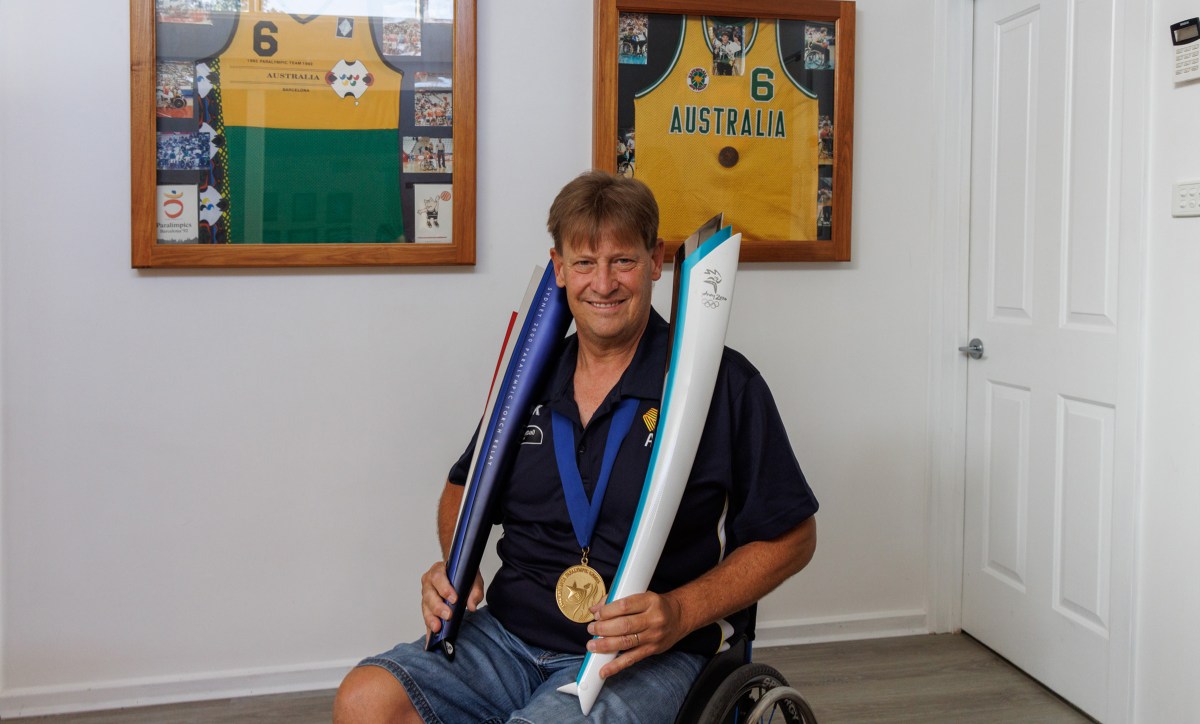
Gould carried both the Olympic and Paralympic torches in the lead up to Sydney 2000. Photo: Tony Lewis/InDaily
While Gould ranks 1996 as his greatest playing achievement, the experience of walking out with Team Australia at the Sydney 2000 Paralympic opening ceremony is something that still moves him today.
“It was just unbelievable,” he said.
“The volunteers at the venue and at the village were super supportive, when we got [to Sydney Olympic Park] there’s journos, there’s helicopters flying around which we never normally get – it was just a buzz.
“Because we’re last, we’re waiting and waiting and waiting to come out, and eventually they call Team Australia.
“As you come up through the tunnel, you could see the light and you could see a few people there. But as you turned, you could just see all the people, and I think it was just 100,000 people there clapping and applauding.
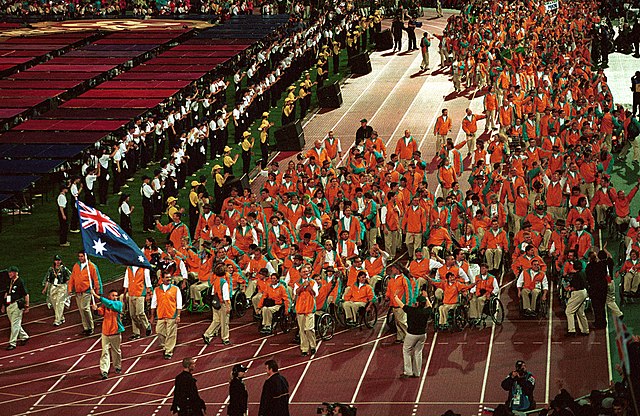
Gould was part of the Australian contingent which walked out to
a stellar reception at the Sydney 2000 Games. Photo: Bill Bachman
“Knowing my wife was there and Ashlee – who was then my youngest daughter – it was just something you never forget and was worthwhile.”
Gould bowed out with a fifth-place finish in Sydney in front of family and a packed home crowd.
He played in one more world championship for Australia in 2002 before retiring as a player for good. Among his most prized possessions is his final playing jersey signed and framed with a series of personal messages from his teammates.
Since retiring, Gould has gone on to have a successful career coaching at both the grassroots and senior level. His résumé includes winning a silver medal as an assistant coach with the Australian women’s wheelchair basketball team at London 2012.
For the last three years, he has worked as a school services officer in the Para Hills disability unit while taking on an afterschool coaching role at King’s Baptist Grammar School.
He lives with his wife Karen and two daughters, Ashlee and Holly, and speaks highly of the SANFL Wheelchair Football League which allows him to play competitively with his two girls.
The 2021 class will be inducted into South Australian Sport Hall of Fame at a black-tie event at Adelaide Oval on April 8. For more details and to purchase tickets, go here.




